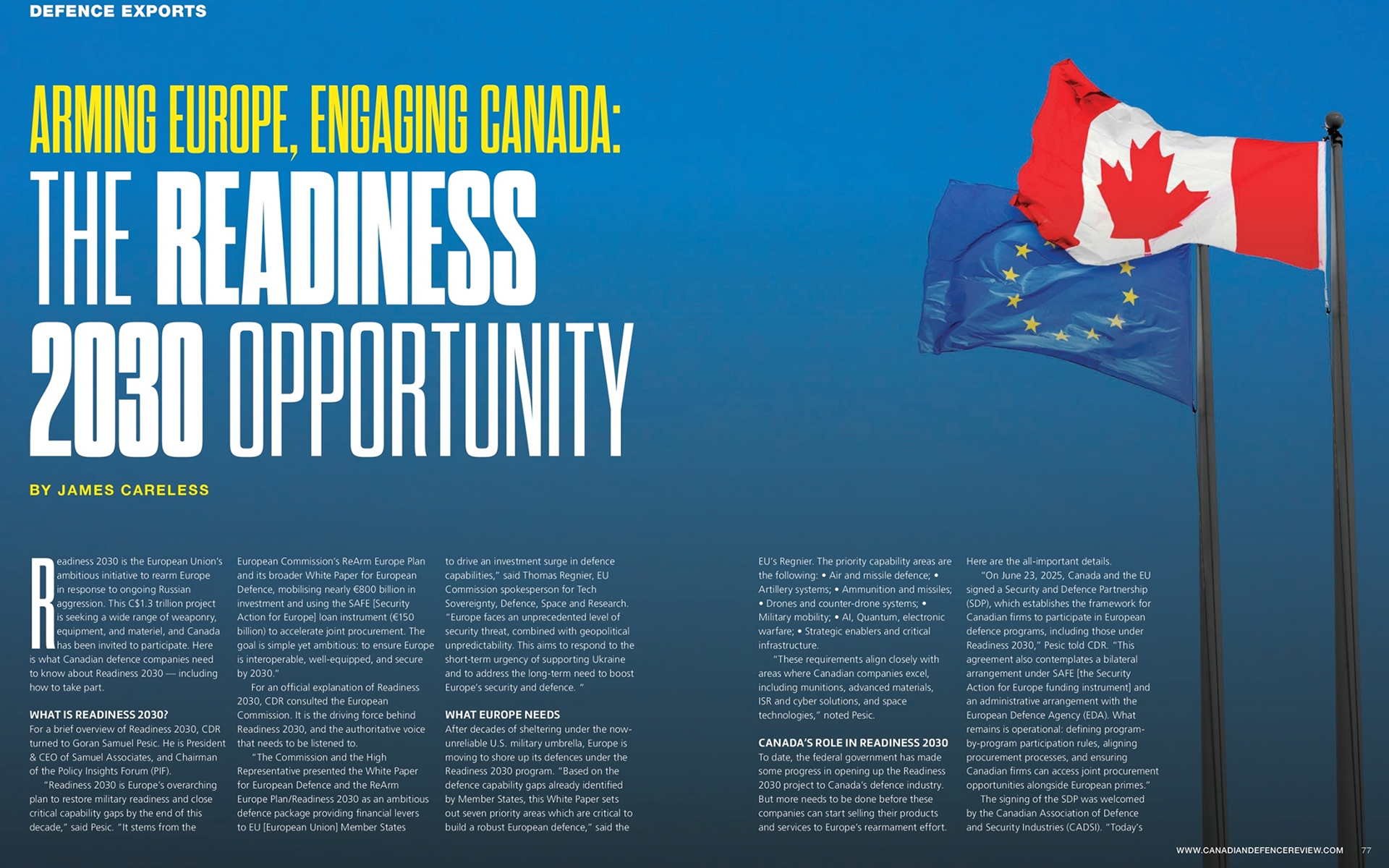Canada’s 2025 Carney Budget: Building a Sovereign Defence Economy


%4010x.png)
Digital Marketing & Communications Specialist
Samuel Associates Inc.
When Prime Minister Mark Carney tabled his first full budget in 2025, it was not simply a fiscal plan, it was a strategic declaration. For a country long accustomed to incremental defence spending and bureaucratic caution, this budget represents an unmistakable pivot toward a new economic and geopolitical doctrine: the fusion of national security, industrial policy, and fiscal sovereignty.
It marks the moment when Canada finally began treating defence not as an expenditure, but as an engine of statecraft.
A Reorientation Toward Strategic Power
Carney’s 2025 Budget sets a clear trajectory: 2 percent of GDP for defence this year, and an ambitious 5 percent by 2035, divided between direct military spending and broader national-security infrastructure. The distinction matters. Ottawa is acknowledging that deterrence today extends beyond fighter jets and frigates. It includes secure telecommunications, domestic manufacturing capacity, and resilient supply chains.
In this sense, the 2025 Budget is less about weapons than about strategic posture. It signals that Canada intends to rejoin the ranks of capable middle powers that can sustain their own defence ecosystems, not merely outsource them to allies or contractors abroad.
The Anatomy of a Rebuild
The defence allocations are sweeping in scale and scope. Over the next five years, Ottawa will invest:
- $20.4 billion for CAF pay and healthcare reform;
- $19 billion for sustaining core military infrastructure and ammunition production;
- $10.9 billion for digital modernization across DND, CAF, and CSE; and
- $17.9 billion for next-generation capabilities such as counter-drone systems, long-range precision strike, logistics vehicles, and domestic munitions plants.
Together, these measures constitute the largest recapitalization of the Canadian Armed Forces in a generation. Yet beyond the numbers lies something more consequential: an attempt to engineer a new civil-military compact between the federal government, the private sector, and the innovation economy.
Industrial Strategy as Statecraft
Perhaps the most transformative element of the Carney Budget is its treatment of industrial capacity as a national-security asset. The creation of BOREALIS — the Bureau of Research, Engineering, and Advanced Leadership in Innovation and Science — with $68.2 million over three years in seed funding, places Canada’s science agencies (ISED, NRC, and CSE) within a single ecosystem for dual-use research coordination.
Simultaneously, a $1 billion Defence and Security Business Mobilization Program housed at the Business Development Bank of Canada (BDC) introduces a quasi-sovereign investment instrument designed to finance small and medium enterprises in the defence and security sector. This is a quiet revolution: the first time a Canadian Crown financial institution has been tasked with mobilizing private capital for national security ends.The budget also channels targeted investments into the technological frontier:
- $656.9 million for dual-use technologies — AI, cyber, aerospace, and biodefence;
- $334.3 million for quantum-technology applications;
- $443 million for critical-minerals processing and allied co-investment;
- $182.6 million to establish a sovereign space-launch capability.
The convergence of these initiatives amounts to an industrial defence ecosystem, linking innovation with deterrence. Carney’s model mirrors what Washington and Brussels have already embraced: a “security-innovation complex” where government, academia, and private capital co-produce strategic advantage.
The Bureaucracy of Power
The establishment of a Defence Investment Agency (DIA) within Public Services and Procurement Canada is an attempt to professionalize Canada’s acquisition bureaucracy, an institution that has too often been synonymous with inertia. The DIA will oversee procurements exceeding $100 million, standardize project delivery, and interface directly with industry through a revitalized Industrial Security Program (funded at $52.5 million).
Critically, the Buy Canadian Policy transforms procurement from a guideline into a statutory requirement: federal departments and Crown corporations must buy domestically unless “trusted-partner” exceptions are explicitly authorized. This marks a philosophical break from decades of laissez-faire procurement. It is the bureaucratic architecture of economic sovereignty.
Finance as a Strategic Weapon
The Budget’s financial architecture extends the logic of statecraft to Canada’s Crown lenders. BDC’s mobilization program provides the domestic engine, while Export Development Canada (EDC) receives an additional $2 billion for its Concessional Trade Finance Envelope, explicitly aimed at facilitating Canadian exports to the Indo-Pacific and the reconstruction of Ukraine.
Taken together, these institutions form a capital corridor between domestic innovation and international influence, what Carney’s allies in London or Washington might call “patient strategic capital.” It marks the beginning of a more confident Canadian geoeconomic policy: one that recognizes finance as an instrument of diplomacy.
Arctic Ambitions and Dual-Use Geography
The new $1 billion Arctic Infrastructure Fund advances another dimension of sovereignty. By investing in northern transportation networks — ports, runways, and all-season roads — Ottawa is building not merely infrastructure but territorial credibility. In the emerging age of Arctic competition, dual-use logistics equal strategic deterrence.
The Fund’s logic is unmistakable: whoever builds the North, governs it.
From Spending to Strategy
The real test for the Carney government will not be appropriations but execution. Coordination among DND, PSPC, ISED, and Crown corporations will determine whether the architecture of a sovereign defence economy can function as intended. Ottawa’s challenge is to move from budgetary ambition to operational delivery. From writing cheques to building capabilities.
The success of this effort will hinge on three factors:
- Speed of Procurement — translating political will into contractual reality.
- Private-Sector Engagement — aligning commercial incentives with national-security outcomes.
- International Synchronization — integrating Canadian initiatives with NATO, AUKUS, and EU partners without diluting sovereignty.
Canada’s New Grand Bargain
In essence, the 2025 Carney Budget proposes a new grand bargain between government, industry, and citizens: that security and prosperity are inseparable. By investing in national capacity — from quantum labs to Arctic ports — Canada is re-imagining its role as a reliable contributor to allied deterrence and an originator of strategic value, not merely a consumer of it.
This is not Keynesian militarism; it is strategic statecraft. Carney’s budget fuses fiscal orthodoxy with geopolitical realism. A recognition that sovereignty today is measured not by the size of one’s surplus, but by the strength of one’s supply chain.
The Samuel Associates View
From our vantage point at the intersection of defence, diplomacy, and industry, Samuel Associates views the 2025 Budget as both a correction and a catalyst. It corrects decades of under-investment and fragmented policy and catalyzes a generational opportunity for Canadian firms to become integral to the nation’s strategic backbone.
The coming years will decide whether this ambition becomes legacy or lost opportunity. But one thing is clear: the era of complacent sovereignty is over.
Canada is rebuilding the foundations of its power. Not through slogans, but through budgets.
%4010x.png)
%4010x.png)




